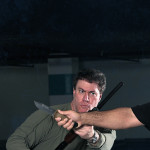People are often surprised when I introduce our basic joint lock flow drill. The surprise comes from a lack of consideration (or knowledge in the case of relatively new students) around our weapons take-away techniques. In their purest format, Krav Maga weapons take-aways are joint locks that have been repurposed.
The basic joint lock flow I teach contains eight locks. Each lock is utilized in the Krav Maga system in some form or fashion – whether it is utilized in a weapon take-away, a basic escort position utilized in Force Training, or a simple takedown. The point of the drill is to allow students to quickly build-up repetitions with these locks and to gain a deeper familiarity with each lock.
While the flow drill is designed to allow each student to respond to negative pressure (fighting the lock) applied back into the path of the joint lock by the attacker, it is not the intention of the drill to prescribe a joint lock response to negative pressure. As with most responses during a technique, your best bet is a strong combative that interrupts your attackers OODA Loop process.
One of the keys to the joint lock flow is to allow the students to not only build-up repetitions but to also focus on how each lock breaks down or pulls apart the attacker’s platforms – moving the hips and shoulders away from one another (and/or the feet). This process quickly and progressively decreases the power an attacker can generate in his/her response.
In the case of the edged weapon, once the lock is applied and utilized to strip the weapon, the attacker’s body should still be in a compromised and weakened position due to the effect on the platforms – leaving a very brief period of time where the defender can withdraw or counter-attack without a powerful response from the attacker (as long as he/she is in a physically compromised position developed through impacting his/her platforms).
Check out the video and give it a try!





T. Younkin
Good drill. Really allows you to begin to recognize opportunities with resistance with some repetition so that when you are working with non prescribed movements, they begin to become more evident.